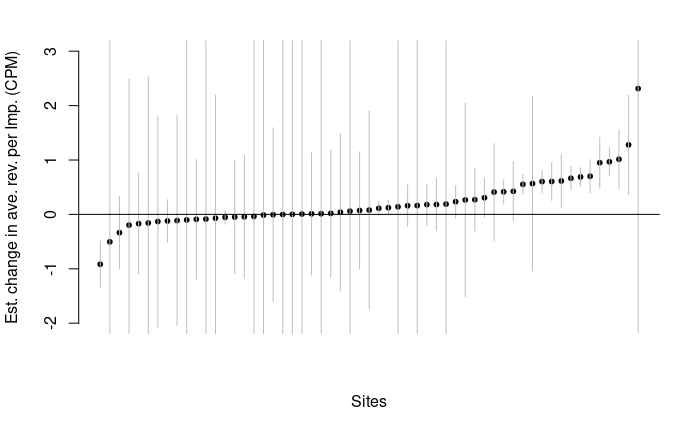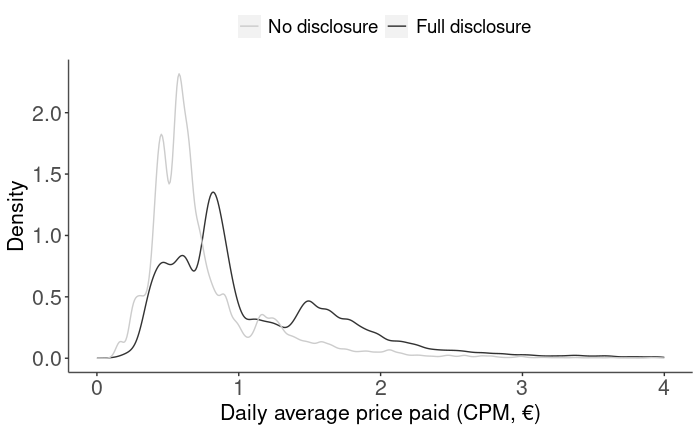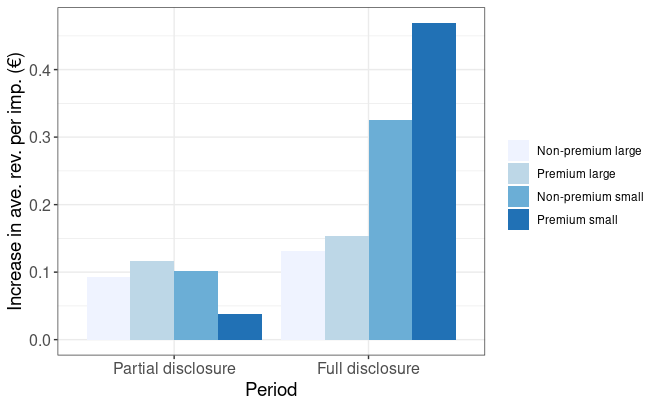Do advertisers care about where their display ads appear?
Some answers from a recent study by @silalom, @nnabout, and @eleafeit. Full paper at https://arxiv.org/abs/2012.00840 .
Some answers from a recent study by @silalom, @nnabout, and @eleafeit. Full paper at https://arxiv.org/abs/2012.00840 .
When a major private RTB ad exchange started providing subdomain information (while previously providing channel info), average prices for impressions increased for nearly all participating websites. The average increase was EUR 0.15 CPM relative to the prior year.
As you can see in this plot, there were only a few sites that saw prices fall when more ad context information was provided.
Why do prices rise? It isn't because publishers exit the market reducing supply. Exactly zero publishers left the exchange after the auction started providing subdomain info in the bid request. And on the demand side, the number of advertisers bidding was fairly flat, too.
These publishers were contractually required to sell all impressions through this platform, so we can also see that there were no changes in the proportion of ads publishers were selling through the auction versus programmatic direct.
So why do prices rise when more context information is provided? Advertisers start bidding higher on sites they each prefer. And if each advertiser puts a premium on a different set of sites, then prices will rise for all sites.
We can see this shift in the data. The distribution of winning prices shifted to have a longer right tail, suggesting that advertisers are adjusting bids upwards for impressions to the right user at the right site. (Thanks @garjoh_canuck for the suggestion.)
Hummel and McAfee have a nice paper that shows theoretically how more information can raise prices in an auction when buyers have independent valuations: https://dl.acm.org/doi/pdf/10.1145/2956586
And @steve_tadelis and @fzettelmeyer find a similar effect in a different type of auction. More information about the quality of used cars led to an increase in auction prices because different buyers prefer different levels of quality: https://dl.acm.org/doi/pdf/10.1145/2956586
Do some sites do better than others when context becomes more transparent? Yes! Lower-traffic sites that provide a premium ad environment saw the greatest increases in price. When the advertisers who value these niche sites know what they are getting, they bid higher.
Do we think that *any* publisher would benefit when the context is more transparent? Probably not. All the sites in this study were brand safe. We expect sites with extremist content or "clickbait" would not fare as well if advertisers really knew what they were buying.
The change in context disclosure we study happened prior to restrictions on user tracking (GDPR, browsers blocking cookies). This means that advertisers value ad context even when they can target users quite precisely.
Our paper provides new evidence that even in digital where users can be targeted quite precisely, advertisers care about what content the user is looking at when they see an ad. Check out the full paper at https://arxiv.org/pdf/2012.00840.pdf.

 Read on Twitter
Read on Twitter





